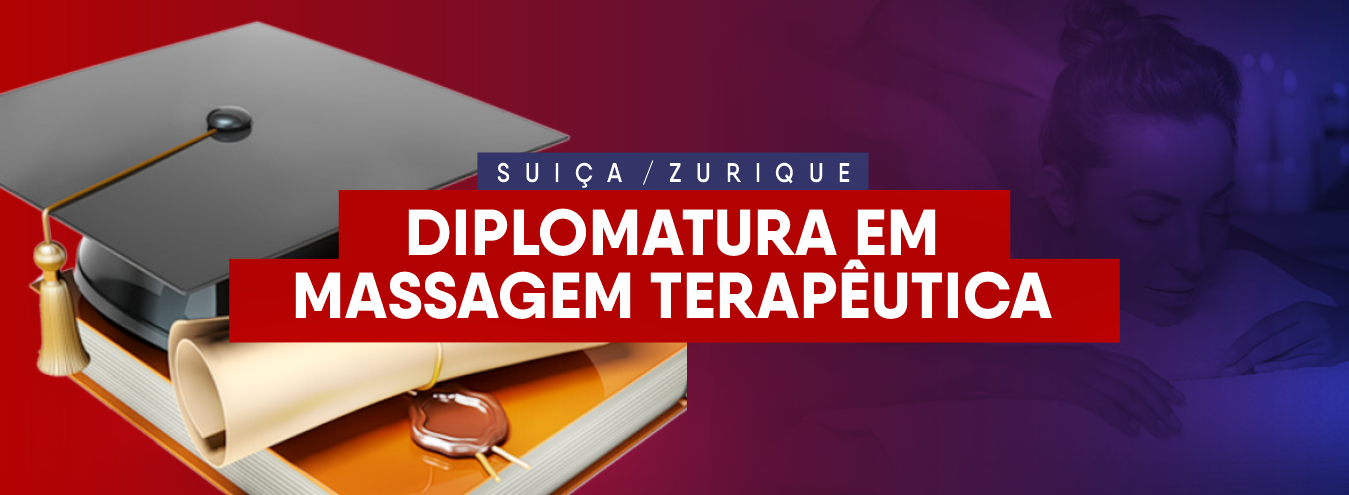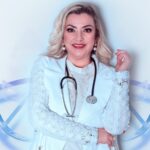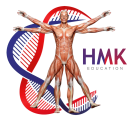- +41 79 607 46 00
- info@hmkeducation.com
- Lerzenstrasse 27, 8953 Dietikon
Diploma in Massage Therapy

- Category: Professional Courses
Lecturer

Patricia M. Lopes (Physiotherapist and Osteopath)
Patricia M.Lopes ( Physiotherapist and Osteopath )
- Workload: 300 hours (150 hours of Academic Medicine and 150 hours of Therapeutic Massage Techniques)
- Language: Portuguese, English, German and Italian
- Certificate: Yes
- Location: Lerzenstrasse 27, 8953 Dietikon
- Theoretical and Practical Class
Course Description
Massage Therapy and its Benefits
After a hectic week, full of commitments and challenges, the body needs a little attention and rest! Many people opt for a relaxing massage to de-stress and feel better. Today, we're going to learn a little more about Therapeutic Massage, which, as well as being relaxing, helps to improve chronic pain, relieving tension and relaxing the muscles.
It's very important to seek a balance in your physical and emotional well-being. Taking care of your body and mind, benefiting from massage as a treatment, is one of the best investments in health. In addition to physiological effects, the various massage techniques bring psychological benefits, such as reduced anxiety and a sense of well-being. Shall we learn more about Massage Therapy? Follow along!
Therapeutic Massage is one of the techniques of Massage Therapy and its differential lies in focusing on the parts of the body that most need treatment. Through maneuvers combined with techniques from Classical Massage, Shiatsu and Stretching, Therapeutic Massage's main function is to obtain results in muscle recovery, in other words, to work on specific areas of the body where there is tension and pain.
Another positive point of this technique is that Massage Therapy is always practiced with personalized and individual attention, which means that its application can be different from person to person. At HMK we have the best courses and we also assess each case individually and both the movements required and the duration of the treatment will be defined on the basis of each patient's needs.
Massage therapy also has a relaxing effect on the body, but its main function is to achieve results in the recovery of muscles that have suffered injuries. This technique is very suitable for athletes, who can benefit after intense training or competitions that have made heavy demands on their bodies. Patients who have a more sensitive or characteristic condition can also benefit from Therapeutic Massage! It is suitable for pregnant women, for example, or for people with specific disabilities who need more complex treatments.
As Massage Therapy is completely personalized, often involving only the area of the body that has been affected and needs treatment, it cannot be practiced by just anyone. Professional massage therapists must be involved in the process.
At HMK your health and well-being come first! Did you identify with Massage Therapy?
Class Schedule EAD / RECORDED LESSONS ON THE HMK PLATFORM, dates and times set by the person in charge of the course (Swiss time).
- Workload: 1338 hours (2 and a half years)
- Language: Portuguese, English, German and Italian
- Certificate: Yes
- Location: Lerzenstrasse 27, 8953 Dietikon
- Theoretical and Practical Class
Classes in person every 6 months, tests and practical classes.
Course Content
1st Module
Legal framework
Profile
Professional Ethics
Job positions
Injury prevention gymnastics
Workplace
Characterization of the client
Anamnesis
Module 3 - Basic concepts of anatomy, physiology and kinesiology
Concepts
Organization and functional structure of the human body
Basic kinesiology
Skeletal system
Muscular system
Integumentary system
Vascular system
Module 4 - Spa Service and Massage
Concepts of reception and customer service
Psychology: interpersonal relationships.
SPA performance protocols
SPA relaxation massage (face, head, shoulders, neck and back)
Module 5 - Initiation to Massage Therapy
Soft tissue disorders and analysis
Chiromassage techniques and maneuvers
Therapeutic back massage
Therapeutic massage for the upper limbs
Lower limb recovery massage therapy
Module 6 - Practice in the workplace
Applying massages to patients invited to the training room.
Module 7 - Physical Rehabilitation Techniques Complementary to Massage Therapy
Thermotherapy by addition and subtraction / Therapeutic stretching / Mobilization / Application of dermal topicals
Module 8 - Therapeutic massage techniques applied to back pain
Therapeutic massage complemented by physical rehabilitation techniques with times, maneuvers and sequences with a decontracting action and anti-algic effect to reduce musculoskeletal pain in dorsalgia.
Therapeutic massage with times, maneuvers and sequences with a decontracting action and anti-algia effect applied to the lower limbs.
Module 9 - Massage therapy techniques for low back pain
Therapeutic massage complemented by physical rehabilitation techniques with times, maneuvers and sequences with a decontracting action and anti-algic effect to reduce musculoskeletal pain in low back pain.
Module 10 - Therapeutic massage techniques applied to cervicalgia
Protocol of:
Therapeutic massage complemented by physical rehabilitation techniques with times, maneuvers and sequences with a decontracting action and anti-algic effect to reduce musculoskeletal pain in cervicalgia.
Module 11 - Therapeutic massage techniques applied to torticollis
Protocol of:
Massage complemented by physical rehabilitation techniques with times, maneuvers and sequences with a relaxing and anti-algic effect applied to torticollis.
Massage contraindications
This is what will determine whether or not I can receive or have a massage session:
1- Fever
Fever is a sign of infection in the body, it indicates that the body is fighting this infection. Consequently, in this case, it is contraindicated because it can spread and worsen the infection.
Therefore, we must be attentive in the anamnesis, take the temperature, and be careful not to massage.
2- Thrombosis
Thrombosis is the formation of a deep blood clot. It can occur in one or more of the body's veins.
And consequently the symptoms are leg pain, swelling, color change. After that, if it is diagnosed, the person already knows that massage is contraindicated.
However, we must also be vigilant when there is still no diagnosis.
Therefore, we must observe and be sure, especially if the person already has more serious venous problems.
3- Renal failure
Kidney problems are a contraindication because massage increases blood and lymph flow, which can overload the kidneys.
4- Newly diagnosed cancer
When someone is starting treatment, they shouldn't receive it, as it could spread the tumor.
However, when the treatment has been completed, the oncologist may even recommend a few massage sessions. This helps a lot at this stage of the disease.
However, there are massage therapists who are trained to deal with cases like this and who also take care of the patient's well-being.
5- injuries to the body
We should be aware of injuries, especially those caused by allergies, burns or wounds. Therefore, massage sessions should not be carried out on damaged or injured skin.
6- Open fracture
We shouldn't massage people who have fractures. We should also check whether the client has osteoporosis problems. Weak bones mean that vigorous massage is not recommended.
7- Liver dysfunction
The liver is an organ that participates in metabolic functions. It can also overload its function with massage.
If the liver case is severe, if not, massage with light pressure can be performed.
8- Heart disease
Because it is a disease of the heart that is not pumping enough blood to the body, massage cannot be performed. Because increasing blood flow in the veins and arteries can make the condition worse.
Cases aside:
Pregnancy: Pregnant women can and should receive massage if they are not at risk. Lymphatic drainage is highly recommended as it helps to reduce edema.
Aids: If it is controlled by medication, it can and is very good for improving immunity.
Menstrual period: If the flow is normal, you can apply moderate pressure, not too intense maneuvers; if the flow is intense and almost hemorrhagic, you shouldn't do it. However, massage is very beneficial during PMS and improves the swelling caused during this period.
Varicose veins: Those fine spider veins don't have to be an impediment to massage, it's even recommended for improving circulation and prevention. However, the pressure should be light, so as not to cause new ruptures.
In the anamnesis you get to know, with a good analysis of the case and the situation presented by each client.
However, if you have the right indication, or if that pathology, you can indicate a contraindication for massage, be it shaping, relaxing or lymphatic drainage.
If you want to learn massage and get started in this profession, check out my course:
2nd Module
Tegumentary Tissue
- Anatomy, Physiology and Biology of the Skin and its Annexes
- Skin microbiota (immune system)
- Intrinsic and extrinsic aging
- Melanocyte Hyperactivity, Melanin, Melanogenesis
- Dermal and Tissue and Muscular Flaccidity
- Glycation Process , ( glycated skin, glycated fibroblasts, glycated hemoglobin
- Skin Examination and Anamnesis
- Skin Management and Functionality
- Dermocosmetics and their applicability on the Skin
- Pathophysiology
- Nutraceuticals , In Out treatments
- Skin Cleansing
3rd Module
Skin Nutrition and Hydration
- Anti-Glycant, anti-oxidants
- Telomere Theory
- Inflammatory Process
- Photo type , Fitzpatrick skin evaluation
- Anamnesis Florescence (Wood's lamp)
- Dyschromias, Hypochromias
- Oxidative Stress
- Mitochondrial Metabolism
- Free radicals, hormone replacement
- Gut health ( microbiota )
4th Module
Acneic Skin
- Anatomy and Physiology of the Skin
- Genotype and skin characteristics
- Acne Physiopathology
- Scars (formation, identification and classification)
- Anamnesis / Evaluation
- Clinical Examination
- Types of skin scars
- Treatments and procedures
- Cosmetics for tissue repair in acne scars
- Concepts of bioidentical growth factors
- Blockade of the melanogenic pathways
- Intercurrences in tissue repair in acne scars
5th Module
Electrotherapeutic Resources in Skin Restoration
- Microdermobrasion, using crystals and the Hydro clean Photonic Platform
- Phototherapy applied to mitochondrial photobiomodulation
- Laser therapy
- Blue, amber and red led
- Ultrasonic
- Microcurrents in protein stimulation
- High Frequency
- Radiofrequency
- Endermology
- Microagulation
6th Module
Fibro-Edema-Geloid (Cellulite)
- Anatomy and Physiology of Adipose Tissue
- Classification and Typology
- Lipogenesis, Lipolysis, Adipogenesis, Localized and Generalized Fat
- Adiposity Assessment (adipomere)
- Therapeutic Goals
- Dermocosmetics
- Resources from
- Electrotherapics: Cryolipolysis, Lipocavitation, Radiofrequency
- Clay Therapy in Destoxification
- Manual Techniques
7th Module
Atrophic Sagging and Scars
- Anatomy and physiology of the Dermis, Epidermis and Muscle tissue
- Atrophic tegumentary scars and their etiology
- Incidence and its location
- Endocrinological Theory
- Infectious Theory
- Inspection and Aesthetic Assessment
- Therapeutic Goals
- Organic and tissue hydration
- Microdermabrasion, peelings, laser, endermology, HIFEM (high intensity electromagnetic stimulation)
- Focal Linear Elastosis
- Cushing's Syndrome
- Marfan Syndrome
- Stretch Marks and Pregnancy
- Evaluation on striated skin
- Orientation and Prevention
- Red and White Stretch Marks their characteristics
Biosafety and First Aid
- Personal and workplace hygiene
- Individual and collective protection equipment, and the correct management of the residues generated in the esthetic clinic
- Diseases transmitted by microorganisms and methods to control the spread of pathologies
- First aid in cases of convulsive crisis, fainting, hemorrhage, asphyxia, burns, musculoskeletal trauma, electric shock, poisoning, and cardiorespiratory arrest
Frequently Asked Questions
Class in Human Anatomy Laboratory, synthetic human body made of silicone very realistic to the real human body, aims to train them in various modalities of investigation and understanding provided by the integration of theory and practice.
In this opportunity, the students were able to learn, through physiology and anatomy, about the constituent parts of the human body and the relationship between all the organs and their functions.
"Although I knew the names of the bones, I had no knowledge about their location and function within the human body. The class in the lab is to improve the knowledge acquired in the classroom.
The Anatomy Laboratory serves to support morphological learning of the organs of the different organ systems.
By taking content from the books to practice in the lab of the Vocational School student,
has several benefits, which can be felt from education to professional life.
Let's learn by doing, is one of the great advantages of a laboratory in the school, the classes are more dynamic, intensive and interesting.
You must have completed high school, or at least be in the 2nd year of high school, and be over 18 years old.
This course is for those who want to work in esthetics, who identify themselves in the area of beauty and health, and who like to relate to people and have manual skills.
Identify, select, and perform facial and body aesthetic procedures, skin cell renewal, depigmentation of blemishes, modulation of sebaceous secretion, stimulation of collagen and elastin and all natural skin growth factors, using cosmetic products, techniques, and equipment, as well as hair procedures, moisturizing the entire functionality and management of the skin.
Elaborate and apply an evaluation program for clients undergoing aesthetic procedures, propose scientific studies for the development of new technologies in the area of aesthetic treatments.
Evaluate body procedures, such as relaxation and wellness, lymphatic drainage and modeling massage, improving physiological edema, favoring the improvement of the lymphatic and venous system and collagen stimulation, preparing the technical opinion in their area of training through electrotherapy mechanism and manual techniques.
Do administrative activities and organize the work environment in aesthetics .
Establish customer relationship strategies.
Tools :
1 stainless steel tray
1 sprayer
1 set of colorless cuvettes: mini(60ml) small (200ml) medium (350ml)
1 set of spoon-shaped measurers
1 set of spatulas ( 6 units )
1 goggle
1 white bath towel
1 anthropometric tape measure or tape measure
2 plastic pipette beads (3ml)
2 glass dappen
2 cotton hair bands with Velcro
2 white face towels
Disposable sheets
Square shaped cotton
Gases , swabs
Roll of pvc film 300x 28cm
Caps, disposable gloves.
Equipment referred to in the course schedule.
White lab coat, with a pocket at knee height, long sleeve for laboratory use, short sleeve for class lecture.
Yes, after passing the course, you will receive your diploma, which is accepted throughout Switzerland and also at European level.
For this, a minimum amount of 80% frequency is required.
Remember that you can make up for your classes, but at a minimal fee per class.
At the end of the course there will be a graduation ceremony with the delivery of the certificate, to celebrate the student's achievement at the end of the course.
The use of a gown is mandatory.
